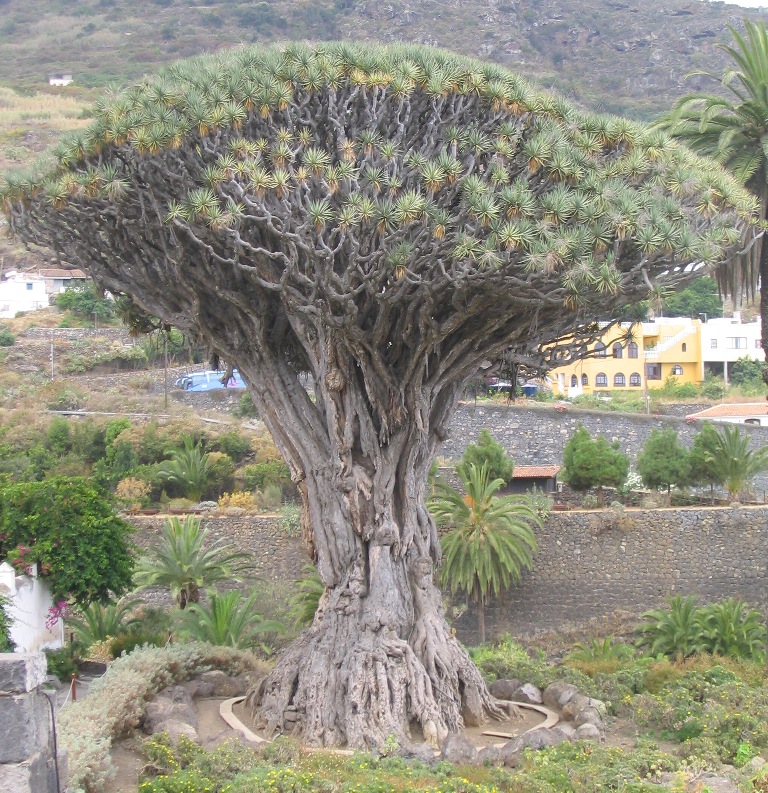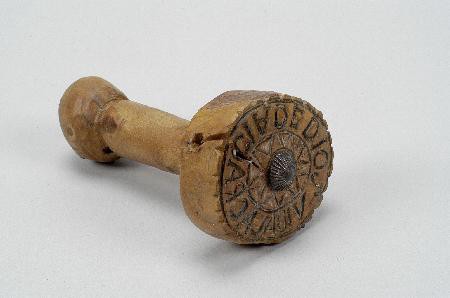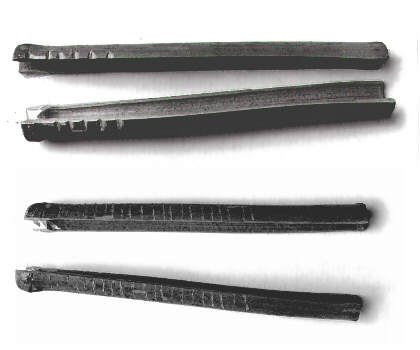
The famous dragon-tree at Icod de los Vinos, Tenerife. This tree-like plant (Dracaena draco) was used by ancient Canarians to make the shields that some authors called “tarjas” (fuente: Wikimedia Commons).
In more or less plausible relationship with the pintaderas cited in the first part of this post, ethnohistorical sources mention the use of badges or emblems among Gran Canaria indigenes. Let us quote some relevant texts.
From Antonio Sedeño‘s account:[1]MORALES (1978, pp. 367, 369). Translated from old Castilian by PROYECTO TARHA.
[…] they brought bucklers taller as a man, made of rough light wood from a tree called dragon. The sword they called Majido and the shield tarja; swords were thin and pointed; they brought their badges painted their way in white and ochre red over the bucklers, played the sword with great skill.
This author, on the account of the famous confrontation between nobleman Bentagaire and warrior Doramas, details:
[…] having Doramas to come that way, they gave signs to Ventagaire he shall be known by the badge of the quartered white-and-red tarja.
From the account by Pedro Gómez Escudero:[2]MORALES (1978, p. 438). Translated from old Castilian by PROYECTO TARHA.
[from dragon tree] they made bucklers to defend themselves, and they were large and painted with badges.
In Cronica Ovetensis:[3]MORALES (1978, p. 123). Translated from old Castilian by PROYECTO TARHA.
[…] a nobleman called Ventagaire, […] came in search of Doramas, having known as signs to recognise him he shall bring his quarter and tarja in white and red, waited for him in the way he used to see his herd […].
Cronica Lacunensis clarifies above cite:[4]MORALES (1978, p. 227). Translated from old Castilian by PROYECTO TARHA.
[Doramas] was bringing his tarja quartered in white and red […].
And in the Chronicle of the Catholic Monarchs, by Diego de Valera:[5]MORALES (1978, p. 501). Translated from old Castilian by PROYECTO TARHA.
And as the Canarians noticed the entrance of the Christians, they gathered three hundred of them armed with swords and tarjas [bucklers?] and helmets and darts to defend the way into the pass.
Brother Juan de Abreu Galindo also tells us about these items:[6]ABREU (1848, p. 70).
[…] Canarians were armed with many weapons […] as darts and stones, and tarjas which were like bucklers, […].
As can be seen, these accounts testify to the existence of certain indigenous defense contraptions called tarjas, which the authors refer to as shields or bucklers featuring badges painted on their surface, possibly similar to the geometric motifs adorning the pintaderas, the ceramic trousseau or certain housing sites such as Cueva Pintada at Gáldar.
The use of these locally-manufactured defenses is not interrupted after the conquest, but continues in the new colonial society as is shown by Tenerife Council minutes in 1501:[7]SERRA (1996, p. 39).
It was ordered and commanded by the Governor, with the consent of the Lords of the Council, that all pawns have the following weapons: spears and dragon-tree tarjas and swords, […] and it is understood that the tarja must be thicker as a thumb and no less.
It is unclear, despite of the first of the above quotations, what the dimensions and exact shape of an indigenous tarja were, much less how it was possible to build one from a trunk of dragon tree (Dracaena draco). We know the latter is not a tree but just, like the palm tree, a tree-like plant and that, as such, it lacks solid wood inside. Therefore, it is not easy to discern whether for the manufacture of these defensive tarjas a cross section or a longitudinal stem, including the bark, was used.
We are not interested here, however, in investigate the constructive aspects of the tarjas but to briefly explore a hypothetical relationship of this term with the pintaderas.

A baker’s “pintadera”. Present name of ancient Canarian stamps derives from this term (source: Paulina Guzmán Tello – Las “pintaderas” de Pan en el siglo XVII – Bread “pintaderas” in the 17th century).
What is a tarja?
In Castilian Spanish language, the terms broquel, rodela and tarja mean different types of shields used in medieval warfare. The first two words coincide in referring to small and round defensive items, while the third can be either a shield large enough to cover an entire human body as a small piece of armor that allowed a knight to protect himself against a spear attack.
While previous testimonies relate the word tarja with certain types of indigenous shield, certain ethnohistorical references point to a possible match, at least phonetic, between two different terms, one European and one African. Let’s see these signs.
In the account by Antonio Sedeño we can read:[8]MORALES (1978, p. 375). Translated from old Castilian by PROYECTO TARHA.
Only one house, that of Guanarthene’s, was found covered with planks of resinous pine wood, so tightly placed that the joints could not be recognised, painted over in soil white and ocher red and ground-coal black, some chequered, and cheese-like round tarjetas across the ceiling.
Note the use of a diminutive of tarja that is very familiar in modern Spanish –tarjeta, card–. In this case, mention of defensive elements is not made but decorative paintings within residential structures: the disappeared Guanarteme of Gáldar’s palace. This allusion to round tarjetas reminds us the concentric circles present in some pintaderas and especially those inside Cueva Pintada at Gáldar.
Let us read below the testimony of historian Tomás Marín de Cubas in 1687, who, besides coinciding in the defensive meaning of the term as to the Doramas episode, added other interpretations: [9]ARIAS (1937, fol 55v, 77, 91. ). Adapted from old Castilian by PROYECTO TARHA.
[…] they painted on dragon-tree planks and upon rocks and cave walls with ocher and lines and other characters called tara, and where they put them on, tarja in the likes of coats of arms […].
[…] and in the Tarjas and taras of the Canarians they knew the years they were on the Island [Gran Canaria] things about this memory and eventually were letting themselves to be discovered; […]
In 1694, Marín de Cubas seems to modify the meaning of the voice tarja:[10]ARIAS (1986, p 254). Adapted from old Castilian by PROYECTO TARHA.
[…] having harvested their crops they made lines either on planks, walls or stones; called them tara, and tarja the memory of what they meant.
Note that Marín de Cubas refers to two interrelated terms. The first one indicates some sort of alphabetical or ideographic writing, and the second one, the physical support on which these graphs were drawn, or rather their semantics. This physician from Telde (Gran Canaria) resembles the tarjas to coats of arms –i.e. blazons– rather than to defensive instruments, but he himself attested in other passages of his works the latter functionality.

“Tarjas” (tallies) preserved at Caravaca de la Cruz (Murcia, Spain). Tallies were the ancestors of credit cards (source: Web Site of the Betanzos Official Chronicler).
Etymology of the word tarja
Although the Dictionary of the RAE offers nine meanings for the word tarja,[11]For an excellent summary (in Spanish) of the historical meanings of this word see Palabraria blog, by Ángel Arteaga. it only gives the etymology for the two defensive-related meanings, the fourth and fifth ones respectively, indicating the word derives from the French targe, whose diminutive gave rise to the English noun target.
However, it tells us nothing about the etymology of the other meanings proposed by the RAE for this word, of which the first three are highly interesting in the present case:
- Tablita o chapa que sirve de contraseña (i.e. A small plank or sheet that serves as a password)
- Corte o hendidura que se hace como señal (i.e. A cut or gap made as a sign)
- Caña o palo sencillo en que por medio de muescas se va marcando el importe de las ventas (i.e. A rod or simple stick on which selling amounts are marked by means of slots)
In fact, the first of these three meanings is linked in its diminutive form to the word tarjeta –card–, which needs no introduction. As for the remaining two meanings, obviously related, it is very illustrative the article titled Los primeros recibos (Muescas contables) –The first receipts (Accounting slots)–, by Engineer Guillermo Searle Hernández, in which certain wood tools that were used in various European and African countries to annotate credit and debit accounts, either in kind –bread, livestock– or in cash, are described.
These tools, called tarjas –tallies– indeed, and whose marking procedure was indicated by the Spanish verb tarjar, are said to have been introduced in the Iberian Peninsula by the Arabs, which in practice really amounts to ascribing a North African origin. Moreover, in countries like Chile, the same term is used to refer to the registration documents used in the provision of marine freight.
May these few samples serve to illustrate the relationship that seems to keep this word with the actions of witnessing, writing and/or recording, right in sequential accordance with the above three meanings. The philological analysis by Professors René Basset in the late nineteenth century, and Dominik Josef Wölfel and Lionel Galand in the 1940s and 1970s, respectively, in addition to the recent review by Dr. Ignacio Reyes García points in that direction.[12]REYES (2012, tarha entry).
In view of these data, it would be feasible to propose a more or less direct relationship of the word tarja with the pintaderas, being objects whose hypothetical functionality seems linked to all or at least some of these three actions. However, as Professor Jorge Onrubia Pintado and Dr. Gabriel Betancor Quintana advise, it is imperative not to fall into a symbolist and speculative hypertrophy, especially in a cultural context in which everything is still to be discovered.[13]ONRUBIA (2002 , pp. 486-488).
Antonio M. López Alonso
References
- Abreu Galindo, Fr. J. de. (1848). Historia de la conquista de las siete islas de Gran Canaria. Santa Cruz de Tenerife: Imprenta, Lithografía y Librería Isleña.
- Arias Marín de Cubas, T. (1937). Historia de la Conquista de las siete Yslas de Canaria. Telde (Gran Canaria): Archivo de don Pedro Cabrera Benítez.
- Arias Marín de Cubas, T. (1986). Historia de las siete islas de Canaria. Las Palmas de Gran Canaria: Real Sociedad Económica de Amigos del País de Gran Canaria.
- Morales Padrón, F. (1978). Canarias: Crónicas de su conquista. Sevilla: Excmo. Ayuntamiento de Las Palmas – El Museo Canario.
- Onrubia Pintado, J.; Betancor Quintana, G. (2002). “La colonización de los signos. Sistemas gráficos y alfabetización de los indígenas de Gran Canaria”, XIV Coloquio de Historia Canario-Americana, pp. 486-507. Las Palmas de Gran Canaria: Cabildo de Gran Canaria.
- Reyes García, I. (2012). Ínsuloamaziq: Diccionario histórico-etimológico del amaziq insular (Canarias). Islas Canarias: Fondo de Cultura Ínsuloamaziq.

2 comments on “On tarjas and pintaderas (2/2)”